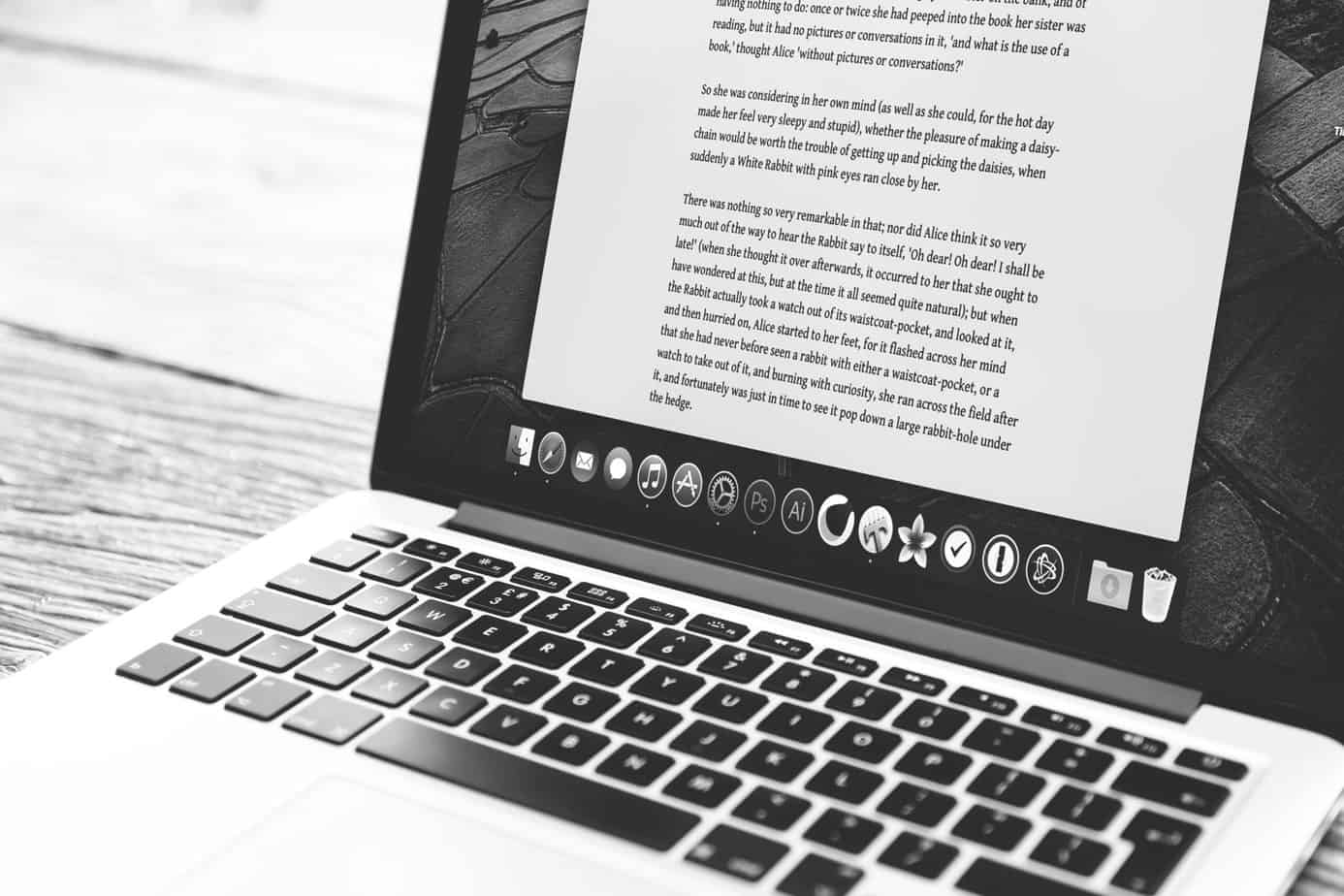Have you ever thought about writing a book? And then directly followed that thought with a softly pained laugh while you mumbled, “Hm, yeah right, I could never.”
The idea of writing a whole novel can be totally daunting. It’s a huge undertaking! But it’s not an impossible undertaking, and that’s what you need to focus on.
Think of it like being handed a plastic bag full of broken up puzzle pieces (most of them are just plain black?! Why!!) and you didn’t get a picture to follow. But once someone hands you the picture and you see how the puzzle is supposed to go together, the whole thing becomes less terrifying and more like a delicious challenge to sink your teeth into. (Except…don’t take this metaphor too far. Do not eat cardboard puzzle pieces.)

If you want to write a book – write a book! I cannot stress enough that no one (not even you) has any right to tell you that you can’t do this. And you know when is a good time to try? Now. Right now.
Let’s get started.
5 Quick Tips for Aspiring Writers
- You don’t have to write anything perfectly the first time. You have infinite chances to rewrite, edit, and improve.
- Don’t compare your first-ever chapter to a published novel. That has been through dozens of drafts and worked on by professionals! You’re not there yet, and that’s totally fine.
- Practise makes perfect. It’s annoying, but it’s true! Write and then write some more. Write as much as you possibly can. You will get better.
- If your writing method isn’t working for you, try something else. There is no “one way” to write a novel.
- Look, stock up on chocolate (or your favorite snack) because you deserve it. Shh, you do. It’s fine. Take the last piece of cake too.
How Do You Start Writing a Book?
My first novel was a thin pile of pages, stapled together and lovingly illustrated, and I had no idea what I was doing, but I was extremely happy. I was also twelve and inspired to write because my younger sister had started and was getting far too much attention to it.
I wanted to do that. Could I do that?! (As they say if you don’t have aspirations of your own…steal someone else’s.) By fifteen, I was writing seriously (a.k.a I was no longer stapling together my novels at least) and by twenty-two, I had a book deal with Hachette.
The biggest thing I can point out here is: I didn’t learn to write overnight. So remember that! Below, we’re going to talk about where and how to start. But you don’t have to be perfect straight away.
1. Start With An Idea

If you want to write a novel, chances are you’ve already got that nugget of an idea glowing in the depth of your soul. There’s also likely gaps in your idea. You haven’t figured out the ending, or maybe you’re not sure who the villain is. That’s fine! The important thing is, you have a story!
Start writing down everything you know about your book. Make a long messy, loving, and creatively excited list. Character names. Bits of scenes you’ve imagined. Anything and everything, no matter how raw.
My favorite method is to imagine my book as a movie, with the scenes, fade-to-black moments, and dramatic cliff-hangers. It helps me visualize my story in a tangible way. When I go to write, I feel like I’m transcribing the movie in my head.
2. Plotter or Pantster
While there are infinite ways to write a novel, there are two main ways authors approach the actual writing process. Either (A) they write an outline so they know what will happen in the book. Or (B) they just start writing and let the story unfurl as they do. Neither is better than the other, so just pick what works for you!
If you’re mildly terrified by empty pages, then I do suggest writing an outline. If you get writer’s block a lot I suggest writing an outline. (Also here are some ways to fight writer’s block.)
But if you hate being told what to do, even by yourself, then don’t write an outline! Let the story take you where it will. Some people’s imaginations work best when they’re left to wander and fill in the story gaps as you write chapters
4. Develop Your characters

Characters are arguably the heart and life of a story. If you want to capture your readers’ emotions, you need to have epic and memorable characters.
If you’re not sure where to start with developing your characters, try thinking of the types of characters you love to read about (or watch in films). Now get to know them. Make them 3-dimensional. You want to populate your novel with characters who feel alive.
Fill out character-interview-questionnaires. Peruse Pinterest and find actors and models who match your characters’ looks or their clothing style.
Do a Hogwarts House quiz for them or a Briggs-Meyer test to figure out more about their personality. Do more than just decide if your character loves cheese and has green eyes. What do they fear? What do they want? Who do they love?
The stronger your characters are, the more they’ll push the story forward and make it active and compelling. Avoid passive characters. Don’t make your characters just react to the plot – make your characters direct the plot.
3. Choose your setting
While I feel characters are the most important part of a story, you can’t neglect the setting! Having a phenomenal, detailed, and explosive world can make or break a fantasy novel.
If you’re writing historical fiction, you want details to make it feel real. Modern setting? Then delve into specifics (wrap secrets into your cozy beach town or put quirks and history into the halls of your school setting).
It’s also important to have multiple settings. Your book will feel stagnant if the characters only travel to one or two places. Brainstorm places your characters can go that will advance the plot.
It doesn’t necessarily have to be a journey! You can even have your romance contemporary novel move from a café to a library to an office workplace to a lantern festival. Different settings give the characters more chances to react and grow, and that will make your book feel tangible and real.
4. Know Where You’re Going

Now I’m a chronic plotter. I can’t launch into writing a book and have no idea where the story is taking me. The very thought makes my eyelashes fall out. But even when I skipped writing outlines, I always figured out what my story was aiming for. What is this story saying? What’s it’s theme? What’s the point?
You might see the word “theme” and absolutely freak out and have traumatic flashbacks to high school English class extrapolating what the blue curtains meant. But a theme is simple!
It can be anything, from a huge concept like “overcoming fear” or something really specific “holding tight to a friend you love”. Here’s a list of some themes to inspire you! When you know what your novel is trying to say, it helps you write a satisfying ending.
Even if you don’t have your theme sorted now, decide where you want your characters to end up by the end. If you’re writing a story about a girl who’s doing everything to win the attention of the super hot high school quarterback… only to find he’s actually DEAD and a GHOST and this is NOT what she had in mind when she wanted a romance. Now she’s roped into keeping his half-dead-secret while they try resurrect him between biology and English class – before you launch in, figure out if they’re going to resurrect him or not. (Also, I made that up as I typed this and…it’s not a bad idea…be right back. The muse calls.)
But also be flexible. If you’ve written ¾ of a book and suddenly get a brilliant idea to make your old ending way better? Do it. Don’t be afraid to change with your story.
5. Have fun with this!

This might seem like a corny note to end on, but trust me: if you’re not having fun, your reader won’t either. So write the story that appeals to you. Think about what you love and hate in other books (or films!) and build off those.
And keep reading! Keep watching movies. Keep listening to music. Give yourself space to daydream. We writers deplete our creative wells so fast when we’re working on our own stories, so keep your enthusiasm for art topped up by making space to appreciate other artists’ work.
Are you writing a Young Adult sci-fi novel? Make sure you’ve read some so you know what’s overdone or not done enough. Are you writing a memoir? (We’ve got amazing tips on how to write a memoir here.) Read other memoirs and see how they shape their stories. And read outside your own genres too, because it makes you a well-rounded and more creatively enthused author.
The most important thing to ask yourself before starting to write a book is: (1) what does my character want? (2) what is stopping them? (3) how far would they go to get their goal?
Finding time to write is hard of course, but remember it’s not a race. Take your time when writing, but just remember to keep writing. You only fail when you quit. You don’t have to write it perfectly the first time, you just have to keep writing.
Beginner Writer Checklist

If you need a TL;DR version of how to get started writing a book, try just working through this simple checklist.
- Come up with an idea.
- Write lists of things that you want to happen in the book.
- Decide who your characters are. What they look like. How they interact. What they want. Why they want it.
- Pick a setting and build your world.
- Decide what the point of your novel is. What is the theme? How do you want the readers to feel when they have finished reading?
- Make your characters react to the plot as you write.
- First drafts don’t have to be perfect. You have infinite chances to write, edit, and rewrite to make it work.
- Have fun with this!
About the Author
CG Drews is a YA book blogger with the goal to read every book in existence. She’s aiming for immortality for this. When not reading, she writes novels and blogs at paperfury.com.



